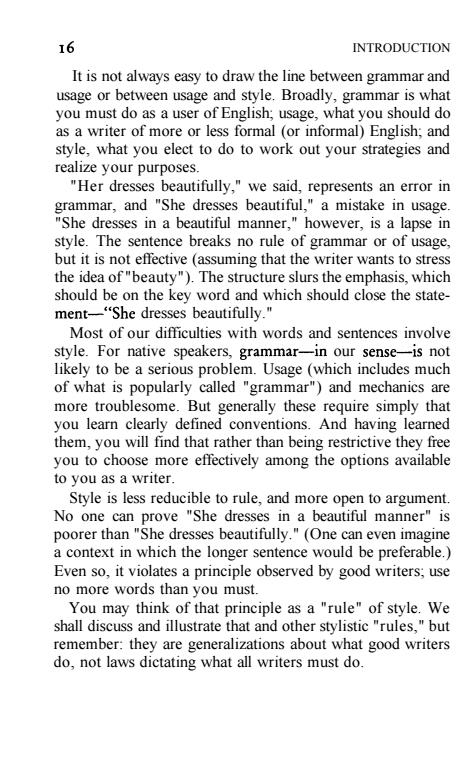正在加载图片...

16 INTRODUCTION It is not always easy to draw the line between grammar and usage or between usage and style.Broadly,grammar is what you must do as a user of English;usage,what you should do as a writer of more or less formal (or informal)English;and style,what you elect to do to work out your strategies and realize your purposes. "Her dresses beautifully,"we said,represents an error in grammar,and "She dresses beautiful,"a mistake in usage. "She dresses in a beautiful manner,"however,is a lapse in style.The sentence breaks no rule of grammar or of usage, but it is not effective (assuming that the writer wants to stress the idea of"beauty").The structure slurs the emphasis,which should be on the key word and which should close the state- ment-"She dresses beautifully." Most of our difficulties with words and sentences involve style.For native speakers,grammar-in our sense-is not likely to be a serious problem.Usage (which includes much of what is popularly called "grammar")and mechanics are more troublesome.But generally these require simply that you learn clearly defined conventions.And having learned them,you will find that rather than being restrictive they free you to choose more effectively among the options available to you as a writer. Style is less reducible to rule,and more open to argument. No one can prove "She dresses in a beautiful manner"is poorer than "She dresses beautifully."(One can even imagine a context in which the longer sentence would be preferable.) Even so,it violates a principle observed by good writers;use no more words than you must. You may think of that principle as a "rule"of style.We shall discuss and illustrate that and other stylistic "rules,"but remember:they are generalizations about what good writers do,not laws dictating what all writers must do.16 INTRODUCTION It is not always easy to draw the line between grammar and usage or between usage and style. Broadly, grammar is what you must do as a user of English; usage, what you should do as a writer of more or less formal (or informal) English; and style, what you elect to do to work out your strategies and realize your purposes. "Her dresses beautifully," we said, represents an error in grammar, and "She dresses beautiful," a mistake in usage. "She dresses in a beautiful manner," however, is a lapse in style. The sentence breaks no rule of grammar or of usage, but it is not effective (assuming that the writer wants to stress the idea of "beauty"). The structure slurs the emphasis, which should be on the key word and which should close the statement—"She dresses beautifully." Most of our difficulties with words and sentences involve style. For native speakers, grammar—in our sense—is not likely to be a serious problem. Usage (which includes much of what is popularly called "grammar") and mechanics are more troublesome. But generally these require simply that you learn clearly defined conventions. And having learned them, you will find that rather than being restrictive they free you to choose more effectively among the options available to you as a writer. Style is less reducible to rule, and more open to argument. No one can prove "She dresses in a beautiful manner" is poorer than "She dresses beautifully." (One can even imagine a context in which the longer sentence would be preferable.) Even so, it violates a principle observed by good writers; use no more words than you must. You may think of that principle as a "rule" of style. We shall discuss and illustrate that and other stylistic "rules," but remember: they are generalizations about what good writers do, not laws dictating what all writers must do